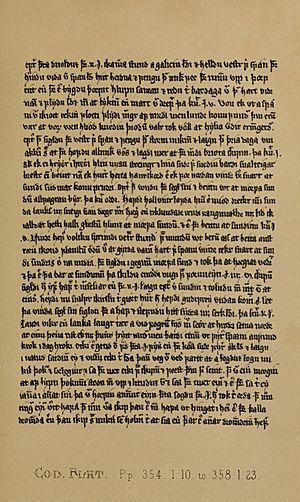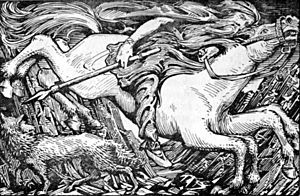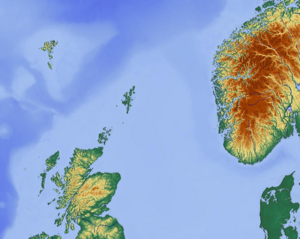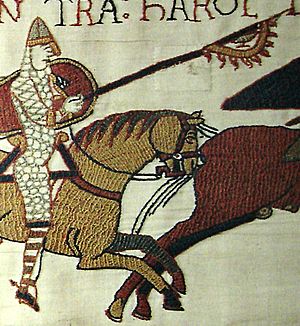Orkneyinga saga facts for kids
The Orkneyinga saga (also known as the History of the Earls of Orkney or Jarls' Saga) is an old story about the Orkney and Shetland islands. It tells about their history and how they connected with other places, especially Norway and Scotland. This saga is very special because it's the only old story that focuses on Orkney as the main setting. It mostly talks about the lives of the jarls (earls) who ruled the Earldom of Orkney, which included both Orkney and Shetland.
The story begins with a short, mythical tale about the ancestors of the jarls. Then, it describes how Harald Fairhair from Norway took over the islands. While it's true that Norway took control, historians don't think the king himself was directly involved in the way the saga describes. The saga then goes on to tell the stories of many jarls who ruled the islands from the 800s to the 1200s. People still debate how much of the earlier parts of the saga are true history and how much is fiction.
The Orkneyinga saga has several main ideas that appear again and again. These include fights between brothers, the relationships between the jarls and the Norwegian kings, and raids in the Hebrides and other places. One reason the saga was written was to give the islanders a history, helping them "understand themselves through knowing where they came from." Even when the history isn't perfectly accurate, it helps us understand what the writers thought and what was important in Orkney in the 1200s.
Contents
How the Saga Was Written
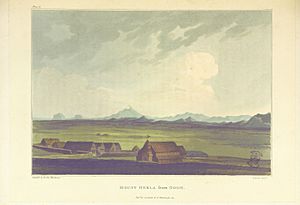
The first version of this Norse saga was written in the late 1100s, but that original text is now lost. A new version was created in the early 1200s by an unknown writer from Iceland. This was about 300 years after some of the earliest events it describes. The Orkneyinga saga is part of a group called "Kings' Sagas," which are histories of the kings of Norway. One famous example is Heimskringla by Snorri Sturluson. Snorri even used the Orkneyinga saga as a source for his own work around 1230. Later, Heimskringla was used to update the Orkneyinga saga.
Like other Icelandic writings from that time, the saga aimed to connect people to their past through exciting stories. It's believed the saga was put together from different sources, like family trees, poems praising leaders, and spoken legends, mixed with historical facts. The Orkneyinga saga specifically tells how the earls of Orkney got their power. One historian joked that writing this saga was like trying to write a history of World War II using only Hollywood movies! It was also hard to put events in exact order because people in those times didn't use "AD" dates.
Historians trust the accuracy of the saga more as it gets closer to the time it was written. For example, the writer Snorri Sturluson had family connections to Earl Harald Maddadsson (who died in 1206), and the first saga document was probably written around the time Harald died.
The oldest complete text of the saga is found in the Flateyjarbók, a large book from the late 1300s. The first translation into English didn't appear until 1873.
Key Stories in the Saga
The first three chapters of the saga are a short folk tale that sets the stage. They talk about characters linked to the elements like snow and flame. It even gives a unique story about how Norway got its name. This legend also says the Orkney jarls came from a giant and king named Fornjót who lived in the far north. This made them seem different and perhaps even more ancient than the Norwegian kings.
After these mythical beginnings, the saga moves on to what seems to be real history.
Harald Fairhair and the Journey West

The next few chapters describe how the Earldom of Orkney was created. These parts are short and less detailed than later events. The saga says that Rognvald Eysteinsson was made Earl of Møre by King Harald Fairhair of Norway. Rognvald joined the king on a big military trip. First, they cleared Orkney and Shetland of vikings who were raiding Norway. Then, they continued to Scotland, Ireland, and the Isle of Man. During this trip, Rognvald's son Ivarr was killed. To make up for this, Harald gave Rognvald Orkney and Shetland. Rognvald then returned to Norway, giving these islands to his brother Sigurd Eysteinsson. The king then officially made Sigurd an earl.
Sigurd "the Mighty" died in a strange way after a battle with Máel Brigte of Moray. Sigurd's son Gurthorm ruled for only one winter and died without children. Rognvald's son Hallad then became earl. But he couldn't stop Danish raids on Orkney, so he gave up the earldom and went back to Norway, which "everyone thought was a huge joke."
Historians now question whether King Harald Fairhair's big journey to the west, described in the saga, actually happened. It's possible the saga writers made up or changed parts of this story to support Norway's claims to the islands in the 1200s. It might also include elements from later expeditions by King Magnus Barefoot.
Torf-Einarr, a Strong Leader
When Hallad failed, Rognvald became very angry and called his other sons, Thorir and Hrollaug. He asked if either wanted the islands. Thorir said it was up to the earl, and Hrollaug was destined for Iceland. Then Einarr, Rognvald's youngest son, stepped forward and offered to go. Rognvald said, "Considering your mother's background, you're not likely to be a great ruler. But I agree, the sooner you leave, the happier I'll be."
Despite his father's doubts, Einarr arrived in the Scottish islands and defeated two Danish warlords who had settled there. Einarr then became earl and started a family line that ruled the islands for centuries.
Einarr is shown with traits linked to the god Odin. Both have only one eye, and Einarr offers the death of an enemy to the god. Einarr is a strong, self-made warrior who avenges his father's death. He leads an exciting life and is seen as "ancient, powerful, and mysterious." He is also a heathen (someone who doesn't follow the Christian faith). His story at the beginning of the saga contrasts with the later story of his Christian descendant, St Magnus, whose death is a "moral high-point" of the story.
Earl Sigurd the Stout
The death of Earl Sigurd Hlodvirsson (980–1014) is one of the earliest events in the earldom's history that we know about from other sources. An Irish text from the 1100s, the Cogadh Gaedhil re Gallaibh, describes the Battle of Clontarf in 1014. It says that Sigurd and others led the "foreigners and Leinstermen," but the Irish eventually pushed them back into the sea. Another old text, the Annals of Ulster, also confirms that "Siuchraid son of Loduir, iarla Innsi Orcc" (Sigurd, son of Hlodvir, Earl of Orkney) died in that battle.
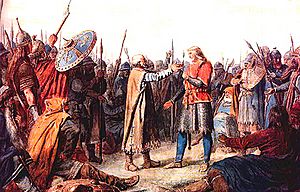
According to the Orkneyinga saga, King Olaf Tryggvasson of Norway made the Northern Isles Christian in 995. The saga says he stopped at South Walls and told jarl Sigurd, "I order you and all your subjects to be baptized. If you refuse, I'll have you killed on the spot and I swear I will ravage every island with fire and steel." Sigurd agreed, and the islands supposedly became Christian right away. However, by the time the sagas were written, Orkney had been Christian for over 200 years. This conversion story is likely not historically accurate. Some believe that when the Norse arrived, Christianity was already present in the Northern Isles, but the sagas don't mention this.
Earl Thorfinn the Mighty
We don't have many other sources to confirm details about Thorfinn Sigurdsson's life. The saga writer seems to have gotten most of his information from a poem written by Thorfinn's own poet after his death.
The Orkneyinga Saga says that a conflict between Thorfinn and Karl Hundason began when Karl became "King of Scots" and claimed Caithness. Thorfinn defeated Karl in a sea-battle. Then, Karl's nephew was killed in Caithness. Finally, a big battle at "Torfness" (likely Tarbat Ness) ended with Karl being killed or forced to flee. The saga says Thorfinn then marched through Scotland, burning and plundering. Because of his military successes, Thorfinn became the ruler of Caithness. He was a vassal (a ruler who owes loyalty) to both the King of Norway and the King of Scots, a role many later earls also held. Thorfinn also became King of the Isles from 1035.
St Magnus, the Holy Earl
Magnus Erlendsson, Thorfinn's grandson, was known for being very religious and gentle. The Norwegians saw this as a sign of cowardice. When King Magnus Barefoot took him hostage, Magnus refused to fight in a Viking raid in Anglesey because of his beliefs. Instead, he stayed on the ship during the Battle of Menai Straits, singing psalms. His brother Erling died while fighting with King Magnus.
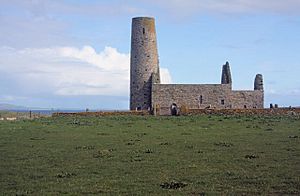
Magnus had to hide in Scotland, but he returned to Orkney in 1105. He argued with his cousin Haakon Paulsson over who should rule. When they couldn't agree, Magnus got help from King Eystein I of Norway, who granted him the earldom of Orkney. They ruled together peacefully until 1114. However, their followers eventually started fighting. The two earls agreed to meet on the island of Egilsay at Easter, each bringing only two ships to make peace. Magnus arrived with his two ships, but Haakon arrived with eight ships, betraying their agreement.
Magnus took shelter in the island's church overnight. The next day, he was captured. An angry Haakon ordered his cook, Lifolf, to kill Magnus by striking him on the head with an axe. It's said that Magnus first prayed for those who were about to kill him. Later, William the Old, the Bishop of Orkney, was struck blind in his church. He regained his sight after praying at Magnus's grave and later declared Magnus a saint. St Magnus Church, Egilsay, was built on the island soon after, near where Magnus was believed to have been killed.
Magnus's nephew, Rögnvald Kali Kolsson, claimed the Earldom of Orkney. His father, Kol, advised him to promise the islanders that he would "build a stone minster at Kirkwall" in memory of his holy uncle. This became St Magnus Cathedral. When the cathedral, started in 1137, was ready, St Magnus's remains were moved there.
Sweyn Asleifsson and Earl Rögnvald

This part of the saga was written only a few decades after Asleifsson's death, so it's likely more accurate than earlier stories. Asleifsson is shown as a typical Viking, a freebooter who enjoyed lively gatherings, caused trouble, and plundered. His support was very important in the politics of the Orkney earldom. Even though he wasn't an earl, his adventures take up a quarter of the saga, and the oldest version ends with his death.
His story is closely linked to Earl Rögnvald, a more complex character who was also a troubadour (a poet and musician) and, like his uncle Magnus, eventually became a saint. The saga writers might have wanted to show them as examples of the Viking way of life. However, it's also possible the saga wanted to show Rögnvald as a weak leader who couldn't control his nobles.
Another way to see the story is that these two men lived in a "golden age" where the earl was a cultured ruler, but he relied on his group of "worthy warriors." This might have been a way to push back against the Norwegian kings' ideas that the crown should have all the power.
While the earls' military strength was highest in the 1000s with Thorfinn "the Mighty," Earl Rögnvald Kali Kolson's time in the 1100s marks the cultural high point of the saga.
Later Earls
Earl Harald "the Old" Maddadsson (around 1134 – 1206) ruled jointly with Earl Rognvald for a long time. King Eystein Haraldsson from Norway raided Orkney and captured Harald near Thurso. Harald was freed after paying a ransom and promising loyalty to Eystein. Eystein then went on to raid the coasts of Scotland and England.
King David I gave half of Caithness to Harald's cousin, Erlend Haraldsson. This led to a power struggle that ended with Erlend's murder in 1154. Sweyn Asleifsson was deeply involved in this family conflict. In 1153, King David died and was replaced by his young grandson, Malcolm IV. King Eystein also died in a war with his brothers. As a result, by 1158, Harald Maddadsson was the undisputed Earl of Orkney, with neither the King of Scots nor the King of Norway able to challenge his power.
The last, short chapters of the later saga describe the lives of Harald's four successors who ruled until Jon Haraldsson was murdered in 1231. This brought an end to the line of Norse earls of Orkney, though Orkney and Shetland remained part of Norway until the 1400s.
History or Story?
There are many doubts about how much of the Orkneyinga saga is true history. For example, the story of King Harald Fairhair's great journey to the west, which supposedly led to the founding of the Orkney earldom, might have been influenced by Norway's conflicts with the Scottish kings over the Hebrides in the mid-1200s. Some parts of Thorfinn's story might have been added to make Earl Harald Maddadsson's adventures seem more legitimate.
Especially in the early parts of the saga, there are clearly fictional elements, like Earl Sigurd's raven banner (a flag with a raven symbol). There are also common Norse storytelling techniques used. For instance, the killing of Rognvald Brusason by Earl Thorfinn "is saga-fiction" and includes typical story elements found elsewhere in the saga. Another example is when Haakon Paulsson meets a fortune teller whose predictions basically list what will happen to him later with his cousin Magnus. This shows how the saga uses storytelling to make the narrative exciting.
However, some events in the saga that were once thought to be fictional have later been found to have some truth. For example, the saga says Earl Sigurd Eysteinsson challenged a local ruler, Máel Brigte the Bucktoothed, to a battle. Sigurd cheated by bringing more men and killed Máel Brigte, taking his head as a trophy. But as Sigurd rode home, Máel Brigte's tooth scratched his leg, which became infected and killed him. Sigurd was buried in a mound called Sigurd's Howe. This mound was likely found in the late 1800s near Dornoch.
Who Was Karl Hundason?
The identity of Karl Hundason, who is not mentioned in Scottish or Irish sources, has been debated for a long time. His existence is only found in the Orkneyinga saga.
Some historians have suggested he was Duncan I or MacBeth. One idea is that "Karl Hundason" might mean "peasant son-of-a-dog" in Norse, which would have been an insult. This suggests it wasn't his real name, so looking for a phonetic match to a known Scottish person might not be helpful.
It seems the war with Hundason happened between 1029 and 1035. The Annals of Ulster record the death of Gillacomgain, a ruler of Moray, in 1032. He is another possible candidate for Thorfinn's Scottish enemy.
Whoever Karl son of Hundi was, it seems the saga is reporting a local conflict with a Scottish ruler from Moray or Ross. It's possible that Thorfinn's campaign wasn't against the Scottish crown itself, but that the Scots might have been his allies against the power of Moray.
Main Ideas in the Saga
Gender Roles
The main characters in the saga are mostly male jarls and kings, along with their male supporters and enemies. However, women are believed to have had a relatively high status during the Viking Age, possibly because people moved around a lot. Women often appear in supporting roles. These include Gunnhild "Mother of Kings"; Ingibiorg "the Earls'-mother", wife of Earl Thorfinn; Frakokk, whose poisoned shirt was involved in a death; and Gunnhild, sister of Magnus Erlendsson and mother of Earl Rognvald.
Orkney and Norway's Relationship
One historian believes the saga's main goal was to connect the history of the earldom with that of the kings of Norway. It aimed to clearly show the relationship between the two regions. This includes ideas like:
- How Orkney submitted to Norway and how Norway had power over Orkney.
- The challenge of being loyal to two kings (Norway and Scotland).
- Norway's use of hostages to control the earls.
- Norway's general goal of making the Orkney earls into royal officials who would pay tribute regularly.
For example, the saga tells how Rognvald Eysteinsson, who received his title from the Norwegian king, gave it to his brother Sigurd. This could be seen as Rognvald not wanting the gift, or it could be the saga writer trying to show both Orkney's independence from Norway (Rognvald gives away the islands) and its dependence on the king (King Harald confirms Sigurd as earl). This might have been the writer's way of emphasizing Orkney's independence at the time the saga was written.
Similarly, the story of Torf-Einarr shows this theme. The saga writer shows Einarr's importance in two ways. While another history calls Rognvald of Møre's family "pirates," the Orkneyinga saga says they had a legally established earldom given by the king. On the other hand, Einarr's success is mostly due to his own efforts, and he negotiates with King Harald rather than just obeying him. This way, the author can emphasize both the legitimacy and independence of Einarr's family line.
Family Conflicts
Having joint earls was common in the Norse earldom, but it was "naturally unstable and usually ended in violence." One historian believes these family feuds are the main theme of the saga, leading up to the death of St Magnus around 1115. The writer emphasizes the tragedy of "kin-slaying" (killing family members). Examples include the deadly fighting among Earl Thorfinn's sons, the deaths of Einar Sigurdsson and his nephew Rognvald Brusason, and the conflict between cousins Haakon Paulsson and Magnus Erlendsson that led to Magnus becoming a saint. The rivalry between the two families started by Paul and Erlend was still strong four generations later when the Orkneyinga Saga was written.
Religion and Morality
Archaeological evidence suggests that Christian burials were already common in Orkney by Sigurd Hlodvirsson's time, even though the saga says King Olaf forcibly converted the islands. The saga might have wanted to show that positive cultural developments came from Scandinavia, while also criticizing Norway's harsh methods.
The story of the raven banner in the saga might suggest a return to old pagan beliefs in Orkney. However, the Orkneyinga Saga contrasts Sigurd's death with the raven banner with his son Thorfinn's later life, where Thorfinn is credited with bringing Orkney more fully into mainstream Christianity. Overall, the saga might aim to highlight this change from paganism to Christianity.
Rögnvald Kali Kolsson's pilgrimage to Jerusalem feels different from the politics and violence in much of the saga. It has romantic touches, and the earl's poetry is highlighted. This episode could be seen as the "central quest" of the saga, and the poetry shows some of the contradictions in medieval Orkney. Society was both pagan and Christian, violence mixed with generosity, and family feuds were common, yet "the bonds of sworn friendship cannot be broken."
Modern Importance
The saga is important not just for scholars trying to understand the Viking Age in the islands, but also for the modern culture of the Northern Isles. The vivid stories of life in Scandinavian Scotland help the "people of Orkney and Shetland recognize themselves as having a dual culture, both Norse and Scottish."
In Popular Culture
The Orkneyinga saga has inspired several modern novels. These include Eric Linklater's The Men of Ness (1932), George Mackay Brown's Magnus (1973), and Linnea Hartsuyker's The Golden Wolf Saga, a three-book series that includes The Half-Drowned King (2017), The Sea Queen (2018), and The Golden Wolf (2019).


